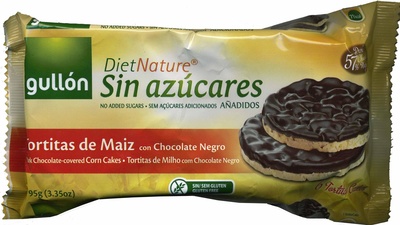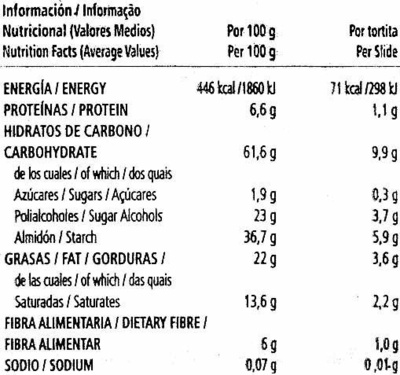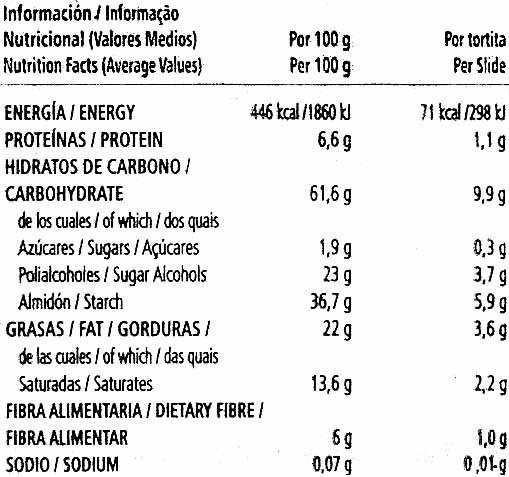Help us make food transparency the norm!
As a non-profit organization, we depend on your donations to continue informing consumers around the world about what they eat.
The food revolution starts with you!
Diet Nature tortitas de maíz - Gullón - 95 g
Diet Nature tortitas de maíz - Gullón - 95 g
This product page is not complete. You can help to complete it by editing it and adding more data from the photos we have, or by taking more photos using the app for Android or iPhone/iPad. Thank you!
×
Barcode: 8410376036701 (EAN / EAN-13)
Common name: Tortitas de maíz con chocolate negro sin azúcares añadidos con edulcorantes
Quantity: 95 g
Packaging: es:Bolsa de plástico y aluminio
Brands: Gullón, Diet Nature
Categories: Plant-based foods and beverages, Plant-based foods, Cereals and potatoes, Cereals and their products, Puffed cereal cakes, Puffed corn cakes, Puffed corn cakes with black chocolate
Labels, certifications, awards: No gluten, Vegetarian, Vegan, No added sugar
Manufacturing or processing places: España
Link to the product page on the official site of the producer: https://gullon.es/producto/tortitas-de-m...
Stores: Carrefour
Countries where sold: Spain
Matching with your preferences
Health
Ingredients
-
13 ingredients
: Chocolate negro sin azúcares 57% (edulcorante: maltitol (E-965 I), manteca de cacao, pasta de cacao, cacao en polvo, emulsionante: lecitina de soja (E-322), aroma), maíz 43%, sal.Allergens: Soybeans
Food processing
-
Ultra processed foods
Elements that indicate the product is in the 4 - Ultra processed food and drink products group:
- Additive: E322 - Lecithins
- Additive: E965 - Maltitol
- Ingredient: Emulsifier
- Ingredient: Flavouring
- Ingredient: Sweetener
Food products are classified into 4 groups according to their degree of processing:
- Unprocessed or minimally processed foods
- Processed culinary ingredients
- Processed foods
- Ultra processed foods
The determination of the group is based on the category of the product and on the ingredients it contains.
Additives
-
E322 - Lecithins
Lecithins are natural compounds commonly used in the food industry as emulsifiers and stabilizers.
Extracted from sources like soybeans and eggs, lecithins consist of phospholipids that enhance the mixing of oil and water, ensuring smooth textures in various products like chocolates, dressings, and baked goods.
They do not present any known health risks.
-
E322i - Lecithin
Lecithins are natural compounds commonly used in the food industry as emulsifiers and stabilizers.
Extracted from sources like soybeans and eggs, lecithins consist of phospholipids that enhance the mixing of oil and water, ensuring smooth textures in various products like chocolates, dressings, and baked goods.
They do not present any known health risks.
-
E965 - Maltitol
Maltitol: Maltitol is a sugar alcohol -a polyol- used as a sugar substitute. It has 75–90% of the sweetness of sucrose -table sugar- and nearly identical properties, except for browning. It is used to replace table sugar because it is half as caloric, does not promote tooth decay, and has a somewhat lesser effect on blood glucose. In chemical terms, maltitol is known as 4-O-α-glucopyranosyl-D-sorbitol. It is used in commercial products under trade names such as Lesys, Maltisweet and SweetPearl.Source: Wikipedia
-
E965i - D-Maltitol
Maltitol: Maltitol is a sugar alcohol -a polyol- used as a sugar substitute. It has 75–90% of the sweetness of sucrose -table sugar- and nearly identical properties, except for browning. It is used to replace table sugar because it is half as caloric, does not promote tooth decay, and has a somewhat lesser effect on blood glucose. In chemical terms, maltitol is known as 4-O-α-glucopyranosyl-D-sorbitol. It is used in commercial products under trade names such as Lesys, Maltisweet and SweetPearl.Source: Wikipedia
Ingredients analysis
-
Palm oil content unknown
Unrecognized ingredients: es:chocolate-negro-sin-azucaresSome ingredients could not be recognized.
We need your help!
You can help us recognize more ingredients and better analyze the list of ingredients for this product and others:
- Edit this product page to correct spelling mistakes in the ingredients list, and/or to remove ingredients in other languages and sentences that are not related to the ingredients.
- Add new entries, synonyms or translations to our multilingual lists of ingredients, ingredient processing methods, and labels.
If you would like to help, join the #ingredients channel on our Slack discussion space and/or learn about ingredients analysis on our wiki. Thank you!
-
Vegan
No non-vegan ingredients
Unrecognized ingredients: es:chocolate-negro-sin-azucaresSome ingredients could not be recognized.
We need your help!
You can help us recognize more ingredients and better analyze the list of ingredients for this product and others:
- Edit this product page to correct spelling mistakes in the ingredients list, and/or to remove ingredients in other languages and sentences that are not related to the ingredients.
- Add new entries, synonyms or translations to our multilingual lists of ingredients, ingredient processing methods, and labels.
If you would like to help, join the #ingredients channel on our Slack discussion space and/or learn about ingredients analysis on our wiki. Thank you!
-
Vegetarian
No non-vegetarian ingredients detected
Unrecognized ingredients: es:chocolate-negro-sin-azucaresSome ingredients could not be recognized.
We need your help!
You can help us recognize more ingredients and better analyze the list of ingredients for this product and others:
- Edit this product page to correct spelling mistakes in the ingredients list, and/or to remove ingredients in other languages and sentences that are not related to the ingredients.
- Add new entries, synonyms or translations to our multilingual lists of ingredients, ingredient processing methods, and labels.
If you would like to help, join the #ingredients channel on our Slack discussion space and/or learn about ingredients analysis on our wiki. Thank you!
-
Details of the analysis of the ingredients
We need your help!
Some ingredients could not be recognized.
We need your help!
You can help us recognize more ingredients and better analyze the list of ingredients for this product and others:
- Edit this product page to correct spelling mistakes in the ingredients list, and/or to remove ingredients in other languages and sentences that are not related to the ingredients.
- Add new entries, synonyms or translations to our multilingual lists of ingredients, ingredient processing methods, and labels.
If you would like to help, join the #ingredients channel on our Slack discussion space and/or learn about ingredients analysis on our wiki. Thank you!
: Chocolate negro sin azúcares 57% (edulcorante (maltitol (e965I)), manteca de cacao, pasta de cacao, cacao en polvo, emulsionante (lecitina de _soja_ (e322)), aroma), maíz 43%, sal- Chocolate negro sin azúcares -> es:chocolate-negro-sin-azucares - percent_min: 57 - percent: 57 - percent_max: 57
- edulcorante -> en:sweetener - percent_min: 9.5 - percent_max: 57
- maltitol -> en:e965 - vegan: yes - vegetarian: yes - percent_min: 9.5 - percent_max: 57
- e965I -> en:e965i - vegan: yes - vegetarian: yes - percent_min: 9.5 - percent_max: 57
- maltitol -> en:e965 - vegan: yes - vegetarian: yes - percent_min: 9.5 - percent_max: 57
- manteca de cacao -> en:cocoa-butter - vegan: yes - vegetarian: yes - ciqual_food_code: 16030 - percent_min: 0 - percent_max: 28.5
- pasta de cacao -> en:cocoa-paste - vegan: yes - vegetarian: yes - ciqual_proxy_food_code: 16030 - percent_min: 0 - percent_max: 19
- cacao en polvo -> en:cocoa-powder - vegan: yes - vegetarian: yes - ciqual_food_code: 18100 - percent_min: 0 - percent_max: 14.25
- emulsionante -> en:emulsifier - percent_min: 0 - percent_max: 11.4
- lecitina de _soja_ -> en:soya-lecithin - vegan: yes - vegetarian: yes - ciqual_food_code: 42200 - percent_min: 0 - percent_max: 11.4
- e322 -> en:e322 - vegan: maybe - vegetarian: maybe - percent_min: 0 - percent_max: 11.4
- lecitina de _soja_ -> en:soya-lecithin - vegan: yes - vegetarian: yes - ciqual_food_code: 42200 - percent_min: 0 - percent_max: 11.4
- aroma -> en:flavouring - vegan: maybe - vegetarian: maybe - percent_min: 0 - percent_max: 9.5
- edulcorante -> en:sweetener - percent_min: 9.5 - percent_max: 57
- maíz -> en:corn - vegan: yes - vegetarian: yes - ciqual_food_code: 9200 - percent_min: 43 - percent: 43 - percent_max: 43
- sal -> en:salt - vegan: yes - vegetarian: yes - ciqual_food_code: 11058 - percent_min: 0 - percent_max: 0
Nutrition
-
Missing data to compute the Nutri-Score
Missing nutrition facts
⚠ ️The nutrition facts of the product must be specified in order to compute the Nutri-Score.Could you add the information needed to compute the Nutri-Score? Add nutrition facts
-
Nutrient levels
-
Fat in high quantity (22%)
What you need to know- A high consumption of fat, especially saturated fats, can raise cholesterol, which increases the risk of heart diseases.
Recommendation: Limit the consumption of fat and saturated fat- Choose products with lower fat and saturated fat content.
-
Saturated fat in high quantity (13.6%)
What you need to know- A high consumption of fat, especially saturated fats, can raise cholesterol, which increases the risk of heart diseases.
Recommendation: Limit the consumption of fat and saturated fat- Choose products with lower fat and saturated fat content.
-
Sugars in low quantity (1.9%)
What you need to know- A high consumption of sugar can cause weight gain and tooth decay. It also augments the risk of type 2 diabetes and cardio-vascular diseases.
Recommendation: Limit the consumption of sugar and sugary drinks- Sugary drinks (such as sodas, fruit beverages, and fruit juices and nectars) should be limited as much as possible (no more than 1 glass a day).
- Choose products with lower sugar content and reduce the consumption of products with added sugars.
-
-
Nutrition facts
Nutrition facts As sold
for 100 g / 100 mlAs sold
per serving (Por tortita 16 g)Compared to: Puffed corn cakes with black chocolate Energy 1,860 kj
(445 kcal)298 kj
(71 kcal)-4% Fat 22 g 3.52 g +14% Saturated fat 13.6 g 2.18 g +17% Carbohydrates 61.6 g 9.86 g -3% Sugars 1.9 g 0.304 g -90% Starch 36.7 g 5.87 g Polyols (sugar alcohols) 23 g 3.68 g Fiber 6 g 0.96 g +23% Proteins 6.6 g 1.06 g -1% Salt ? ? Fruits‚ vegetables‚ nuts and rapeseed‚ walnut and olive oils (estimate from ingredients list analysis) 0 % 0 %
Environment
-
Eco-Score C - Moderate environmental impact
⚠ ️Select a country in order to include the full impact of transportation.The Eco-Score is an experimental score that summarizes the environmental impacts of food products.→ The Eco-Score was initially developped for France and it is being extended to other European countries. The Eco-Score formula is subject to change as it is regularly improved to make it more precise and better suited to each country.Life cycle analysis
-
Average impact of products of the same category: B (Score: 63/100)
Category: Puffed cereals textured bread
Category: Puffed cereals textured bread
- PEF environmental score: 0.40 (the lower the score, the lower the impact)
- including impact on climate change: 1.43 kg CO2 eq/kg of product
Stage Impact Agriculture
81.3 %Processing
8.0 %Packaging
6.0 %Transportation
4.5 %Distribution
0.2 %Consumption
0.0 %
Bonuses and maluses
-
Missing origins of ingredients information
Malus: -5
⚠ ️ The origins of the ingredients of this product are not indicated.
If they are indicated on the packaging, you can modify the product sheet and add them.
If you are the manufacturer of this product, you can send us the information with our free platform for producers.
-
Packaging with a medium impact
Malus: -10
Shape Material Recycling Impact Bag Plastic High
Eco-Score for this product
-
Impact for this product: C (Score: 48/100)
Product: Diet Nature tortitas de maíz - Gullón - 95 g
Life cycle analysis score: 63
Sum of bonuses and maluses: -15
Final score: 48/100
-
Carbon footprint
-
Equal to driving 0.7 km in a petrol car
143 g CO² per 100g of product
The carbon emission figure comes from ADEME's Agribalyse database, for the category: Puffed cereals textured bread (Source: ADEME Agribalyse Database)
Stage Impact Agriculture
56.1 %Processing
10.8 %Packaging
19.7 %Transportation
13.0 %Distribution
0.3 %Consumption
0.0 %
Packaging
-
Packaging with a medium impact
-
Packaging parts
Bag (Plastic)
-
Packaging materials
Material % Packaging weight Packaging weight per 100 g of product Plastic
-
Transportation
-
Origins of ingredients
Missing origins of ingredients information
⚠ ️ The origins of the ingredients of this product are not indicated.
If they are indicated on the packaging, you can modify the product sheet and add them.
If you are the manufacturer of this product, you can send us the information with our free platform for producers.Add the origins of ingredients for this product Add the origins of ingredients for this product
Report a problem
-
Incomplete or incorrect information?
Category, labels, ingredients, allergens, nutritional information, photos etc.
If the information does not match the information on the packaging, please complete or correct it. Open Food Facts is a collaborative database, and every contribution is useful for all.
Data sources
Product added on by javichu
Last edit of product page on by packbot.
Product page also edited by maylord, roboto-app, thaialagata.










